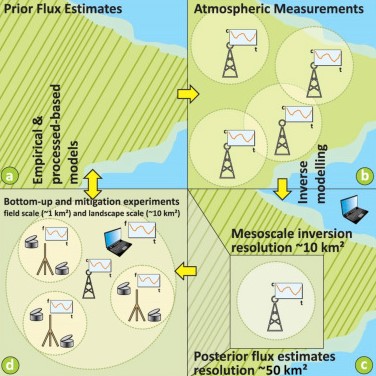
ICOS has contributed to a recent article titled “A complete rethink is needed on how greenhouse gas emissions are quantified for national reporting” published in the Atmospheric Environment, a well-known peer-reviewed scientific journal.
Authors, several of them involved in ICOS, argue that in support of the COP21 agreements, observations should be better utilized to get better estimates of actual greenhouse gas budgets of regions instead of the current practice of relying only upon statistical information. The publication continues to argue that especially in-situ observational networks should be expanded and that improved inverse transport models should be applied on these observational constraints to derive at greenhouse gas budgets for cities, regions and countries.
Picture: Schematic showing how a GHG emission assessment system could be designed. (a) Prior flux estimates provided by global Tier 1 GHG emission inventories or from national data, if available. (b) A (global) network of atmospheric observations for use in inverse models yielding national-scale optimized emissions, which will be submitted to e.g. the UNFCCC. (c and d) Validation of the results using nested meso-scale inversions (resolution of ∼10 km2), which will be compared to flux measurements (e.g. Eddy Covariance and chambers). Meso-scale experiments could also be employed in emission hot-spots to test mitigation strategies and could help with the verification of process-based models. Improvements to bottom-up estimates will be used to revise the GHG emission inventories.